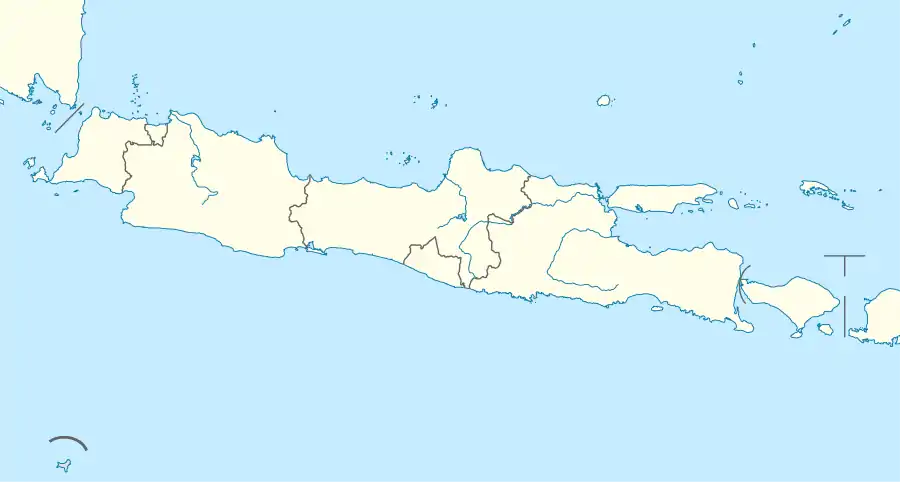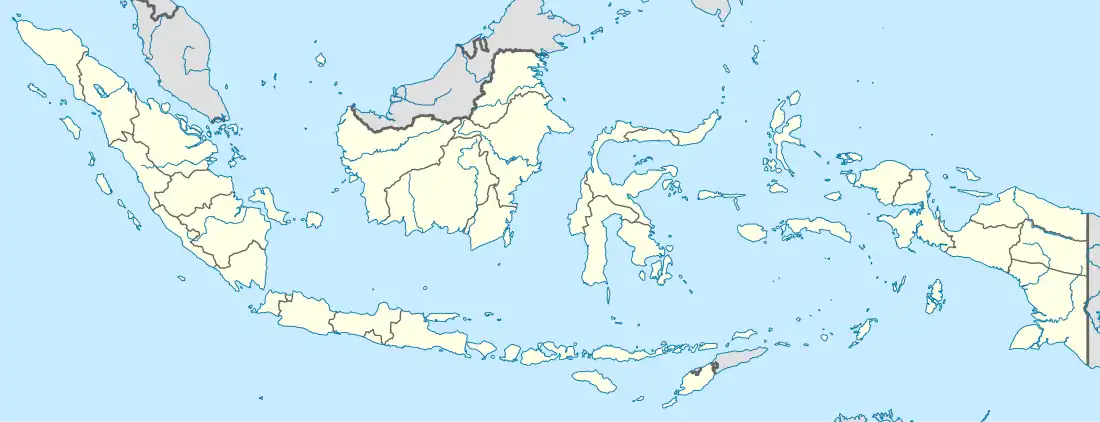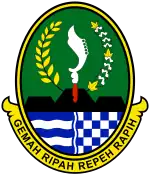Cimahi
Cimahi (Indonesian pronunciation: [tʃimahi]) is a landlocked city located immediately west of the larger city of Bandung, in West Java Province, Indonesia and within the Bandung Metropolitan Area. It covers an area of 42.48 km2 and had a population at the 2010 Census of 541,177[2] and at the 2020 Census of 568,400;[3] the official estimate as at mid 2021 was 575,235 (comprising 290,081 males and 285,154 females).[1] The city is a major textile producer, and is home to several military training centres.[4]
Cimahi | |
|---|---|
| City of Cimahi Kota Cimahi | |
| Other transcription(s) | |
| • Sundanese | ᮎᮤᮙᮠᮤ |
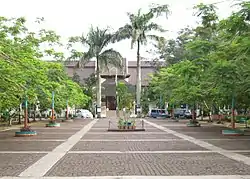 Alun-alun Cimahi | |
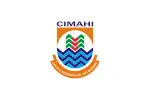 Flag  Coat of arms | |
| Motto(s): Saluyu Ngawangun Jati Mandiri (Harmoniously walking together towards independent identity) | |
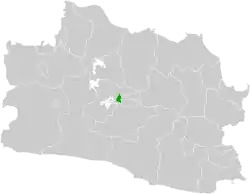 Location within West Java | |
| Coordinates: 6°52′16″S 107°33′17″E | |
| Country | Indonesia |
| Province | West Java |
| Government | |
| • Acting Mayor | Dikdik Suratno Nugrahawan |
| • Vice Mayor | Vacant |
| Area | |
| • Total | 42.48 km2 (16.40 sq mi) |
| Elevation | 685 m (2,247 ft) |
| Population (mid 2022 estimate) | |
| • Total | 575,235 |
| • Density | 14,000/km2 (35,000/sq mi) |
| [1] | |
| Time zone | UTC+7 (Indonesia Western Time) |
| Area code | +(62) 22 |
| Website | cimahikota.go.id |
Geography
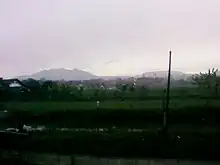
Cimahi, located 180 km south east of Jakarta, is situated between Bandung and West Bandung Regency.[5] Cimahi comprises three districts (kecamatan), which in turn are sub-divided into fifteen urban villages (kelurahan). Its lowest elevation is 685 metres (2,247 ft) above sea level and directs to Citarum River. Its highest elevation is 1,040 metres (3,410 ft) above sea level, which is part of the slope of mount Tangkuban Perahu and Burangrang. The Cimahi River flows through the city and Cimahi also has two Springs, named Cikuda and Cisontok.[6]
Climate
Cimahi has an elevation moderated tropical rainforest climate (Af) with moderate rainfall from June to September and heavy rainfall from October to May.
| Climate data for Cimahi | |||||||||||||
|---|---|---|---|---|---|---|---|---|---|---|---|---|---|
| Month | Jan | Feb | Mar | Apr | May | Jun | Jul | Aug | Sep | Oct | Nov | Dec | Year |
| Average high °C (°F) | 26.7 (80.1) |
26.9 (80.4) |
27.5 (81.5) |
27.9 (82.2) |
28.0 (82.4) |
27.6 (81.7) |
27.6 (81.7) |
28.2 (82.8) |
28.9 (84.0) |
28.9 (84.0) |
28.0 (82.4) |
27.4 (81.3) |
27.8 (82.0) |
| Daily mean °C (°F) | 22.8 (73.0) |
22.8 (73.0) |
23.1 (73.6) |
23.3 (73.9) |
23.2 (73.8) |
23.3 (73.9) |
21.9 (71.4) |
22.2 (72.0) |
22.9 (73.2) |
23.3 (73.9) |
23.1 (73.6) |
23.0 (73.4) |
22.9 (73.2) |
| Average low °C (°F) | 18.9 (66.0) |
18.7 (65.7) |
18.7 (65.7) |
18.7 (65.7) |
18.4 (65.1) |
17.0 (62.6) |
16.3 (61.3) |
16.3 (61.3) |
16.9 (62.4) |
17.7 (63.9) |
18.2 (64.8) |
18.6 (65.5) |
17.9 (64.2) |
| Average rainfall mm (inches) | 259 (10.2) |
236 (9.3) |
269 (10.6) |
271 (10.7) |
188 (7.4) |
87 (3.4) |
77 (3.0) |
83 (3.3) |
96 (3.8) |
189 (7.4) |
292 (11.5) |
309 (12.2) |
2,356 (92.8) |
| Source: Climate-Data.org[7] | |||||||||||||
History
The name Cimahi was taken from the Cimahi river that flows through the city. The word originated from the Sundanese language and literally means "enough water". Residents of Cimahi get their water supply from the river.[8]
Cimahi's prominence increased in 1811, when Governor-General Herman Willem Daendels constructed the Great Post Road. A checkpoint, known as Loji, was built in Cimahi Square. Between 1874 and 1893, the Cimahi rail station and a railroad connecting Bandung and Cianjur was built. The building of military training centers and other military buildings was started in 1886. Cimahi was granted district status in 1935. In 1975, Cimahi became the first administrative city in West Java and the third in Indonesia. Cimahi was then granted full city status in 2001.[9]
Administrative districts
The city of Cimahi is divided into three administrative districts (Indonesian: kecamatan), tabulated below with their areas and their populations at the 2010 Census[2] and the 2020 Census,[3] together with the official estimates as at mid 2022.[1] An elected mayor leads the city administration. The table also includes the locations of the district administrations, the number of administrative villages (urban kelurahan) in each district and its post codes.
| Name of District (kecamatan) | Area in km2 | Pop'n Census 2010 | Pop'n Census 2020 | Pop'n Estimate mid 2022 | Admin centre | No. of villages | Post codes |
|---|---|---|---|---|---|---|---|
| Cimahi Selatan (South Cimahi) | 14.86 | 230,623 | 240,990 | 243,480 | Utama | 5 | 40531 - 40535 |
| Cimahi Tengah (Central Cimahi) | 13.48 | 163,070 | 161,758 | 162,040 | Cimahi | 6 | 40521 - 30526 |
| Cimahi Utara (North Cimahi) | 14.14 | 147,484 | 165,652 | 169,720 | Cibabat | 4 | 40511 - 40514 |
| Total city | 42.48 | 541,177 | 568,400 | 575,235 | 15 |
Tourism
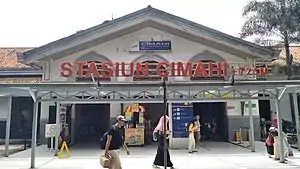
Cimahi has various tourist hotspots, such as Alam Wisata Cimahi, Pandiga Recreation Sport, Rumah Pajang, Lembur Batik and Kampung Adat Cirendeu. According to the local tourist office, these offer distinctive experiences in nature, cuisine, handicrafts and traditional community.[10] Additionally, there are some buildings of historical interest, such as Dustira Hospital, Ereveld Cemetery, Military Prison and Sudirman Building.[11]
Notable people
- Ariffien (1902–1976), Indonesian nationalist and film director
- Jacoba van Tongeren (1903–1967), social worker and Dutch resistance member
- Suardi Tasrif (1922–1991), journalist, author, and political advocate
- Bep Stenger (1922–2016), aid worker and resistance member
- Amir Machmud (1923–1995), former military general and politician[12]
- Dries Holten (1936–2020), singer and songwriter
- Maria Hertogh (1937–2009), born in Tjimahi and the person at the centre of the 1950 Maria Hertogh riots in Singapore
- Jack Jersey (1941–1997), singer, composer, arranger, lyricist and record producer
- Siwi Sukma Adji (born 1962), former admiral and Chief of Staff of the Indonesian Navy
- Doni Monardo (born 1963), former military general and National Agency for Disaster Countermeasure chairman
- Sule (born 1976), comedian[13]
- Widya Saputra (born 1985), television presenter
- Anthony Sinisuka Ginting (born 1996), badminton player
- Zalnando (born 1996), football player
References
- Badan Pusat Statistik, Jakarta, 2023, Kota Cimahi Dalam Angka 2023 (Katalog-BPS 1102001.3277)
- Biro Pusat Statistik, Jakarta, 2011.
- Badan Pusat Statistik, Jakarta, 2021.
- "PENGANTAR DARI WALIKOTA CIMAHI" (in Indonesian). Archived from the original on 4 March 2016. Retrieved 16 September 2015.
- "GEOGRAFI" (in Indonesian). Archived from the original on 4 March 2016. Retrieved 16 September 2015.
- "Data Wilayah" (in Indonesian). Archived from the original on 27 June 2015. Retrieved 16 September 2015.
- "Climate: Cimahi". Climate-Data.org. Retrieved 12 November 2020.
- "SEJARAH" (in Indonesian). Archived from the original on 4 March 2016. Retrieved 16 September 2015.
- "Sejarah" (in Indonesian). Archived from the original on 22 August 2015. Retrieved 16 September 2015.
- "WISATA" (in Indonesian). Archived from the original on 17 April 2016. Retrieved 16 September 2015.
- "Heritage Dan Pusat Pendidikan Militer" (in Indonesian). Archived from the original on 17 April 2016. Retrieved 16 September 2015.
- "Sumber". www.tokohindonesia.com (in Indonesian). Archived from the original on 20 June 2015. Retrieved 16 September 2015.
- "Biografi Sule" (in Indonesian). Retrieved 16 September 2015.
